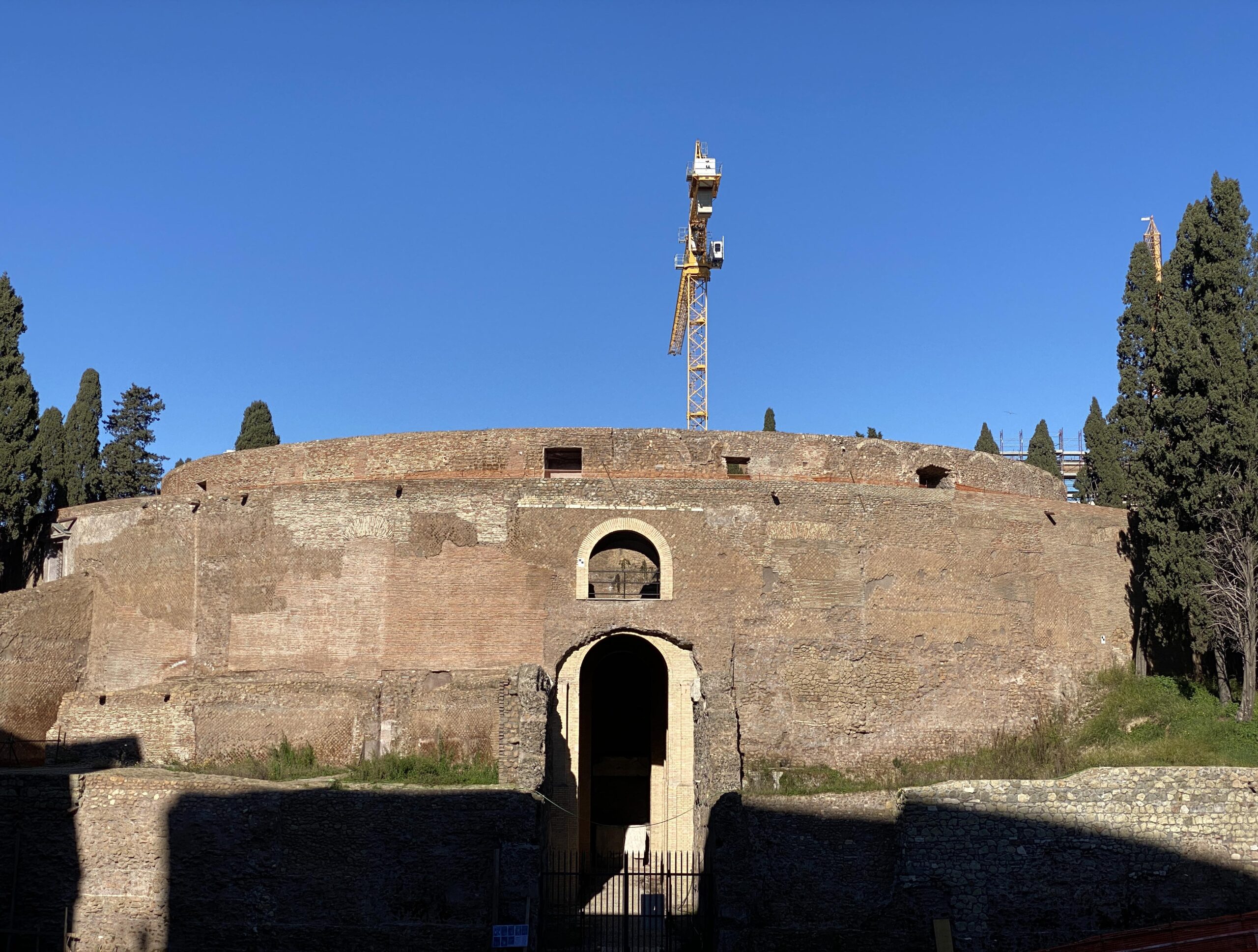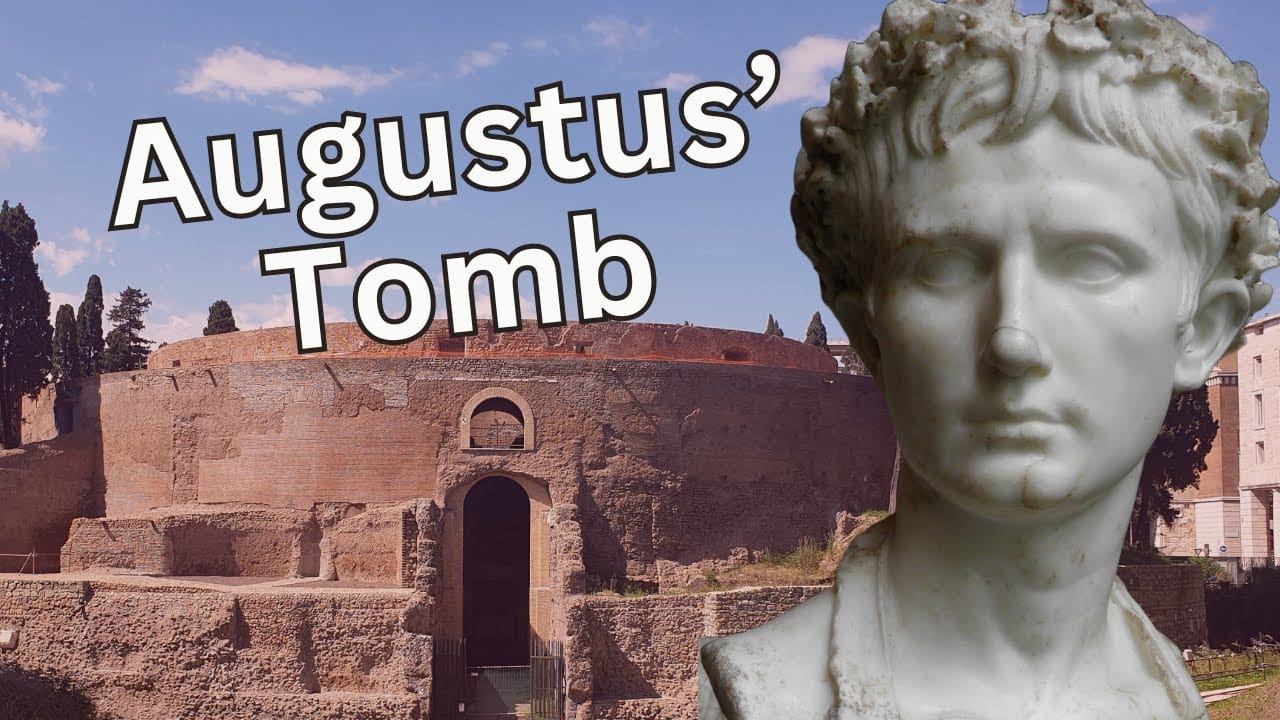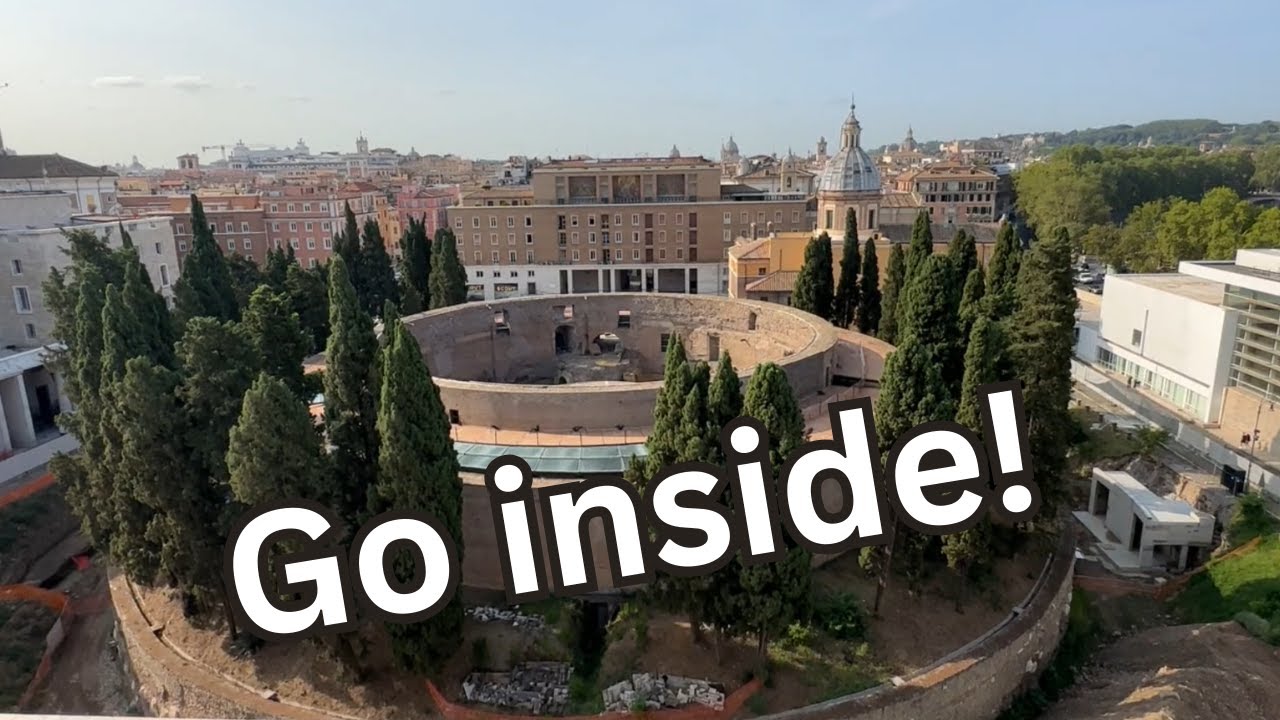Built by Augustus around 28 BCE, the mausoleum was a feat of engineering. Boasting a diameter of nearly 89 meters and a height of 50 meters, it was one of the largest buildings in ancient Rome. Its foundation, made of concrete, supported an exterior adorned with elegant marble and travertine.
The mausoleum was topped with a statue of Augustus, and it was flanked by two Egyptian obelisks. These obelisks can still be found in Rome, on the Quirinal hill and in front of Santa Maria Maggiore. Inspired by the Mausoleum of Halicarnassus, one of the seven wonders of the ancient world, the Mausoleum of Augustus aimed to replicate its grandeur and design.
The Mausoleum of Augustus was the final resting place of multiple Roman emperors, empresses, and members of the Julio-Claudian family. The most famous burials include…
- Marcellus – 23 BCE
- Agrippa – 12 BCE
- Octavia (sister of Augustus) – 11 BCE
- Drusus (father of Claudius) – 9 BCE
- Augustus – 14 CE
- Livia – 28 CE
- Tiberius – 37 CE
- Germanicus – 19 CE
- Antonia (mother of Claudius) – 37 CE
- Caligula – 41 CE
- Claudius – 54 CE
- Nerva – 98 CE
- Julia Domna – 217 CE (later moved to the Mausoleum of Hadrian)
After the fall of Rome, the Mausoleum of Augustus fell into disrepair. In the Middle Ages, it was converted into a church then used as a castle and fortress. Later, it was used as a private garden, a bull fighting ring, and a concert hall. Archeological excavations began in the 1930’s, and the site was finally opened to the public in 2021.
If you like the Mausoleum of Augustus, check out our entry on the Mausoleum of Hadrian. Completed in 139 CE, it was the final resting place of several emperors from the Antonine and Severan dynasties.
Bibliography:
- Grout, James. (n.d.). “The Mausoleum of Augustus.” University of Chicago. https://penelope.uchicago.edu/~grout/encyclopaedia_romana/romanurbs/mausoleumaugustus.html
MAUSOLEUM AUGUSTI, * the mausoleum erected, as a dynastic rather than as a personal monument (we may note that it had become customary to grant the privilege of burial in the campus Martius to persons of distinction by special decree of the senate), by Augustus for himself, his family, and his successors in the northern part of the campus Martius, between the via Flaminia and the Tiber, as early as 28 B.C. (Suet. Aug. 100:(mausoleum) inter Flaminiam viam ripamque Tiberis sexto suoconsulatu extruxerat, circumiectasque silvas et ambulationes in usum populiiam turn publicarat; Strabo v. 3. 9, p. 236: τὸ Μαυσώλειον καλούμενον, ἐτὶκρηπῖδος ὑψηλῆς λευκολίθου πρὸς τῷ ποταμῷ χῶμα μέγα, ἄρχικορυφῆς τοῖς ἀειθαλέσι τῶν δένδρων συνηρεφές. ἐπ̓ ἄκπῳ μὲν οὖνεἰκών ἐστι χαλκῆ τοῦ Σεβαστοῦ καίσαπος, ὑπὸ δὲ τῷ χώματι θῆκαίεἰσιν αὐτοῦ καὶ τῶν συγγενῶν καὶ οἰκείων, ὄπισθεν δὶ μέγα ἄλσοςπεριπάτους θαυμαστοὺς ἔχον); Fasti Cupr. (CIL i². p. 62): [ma]esol[eum]; Mart. ii. 59. 2: Caesareus tholus (see MICA AUREA). It was thus the first building which he erected in the Campus Martius, and characterises his conception of the principate (HJ 497).
Read more:
From these passages and from the existing remains we may gather that it consisted of a large circular drum, faced with travertine, or, as some think, marble; this was 87 metres in external diameter at the base. Above it rose an upper arcade, traces of which may be seen in all the sixteenth century views, and there were probably other tiers above, planted with evergreen trees, while at the summit was a bronze statue of Augustus. The entrance was on the south, with a small chamber over it, lighted by a window; and the passage way, 3.5 metres wide, led through a double ring of (originally) closed chambers to a wall in which there were two doorways, one on each side of the mass of concrete in front of the passage way. This wall runs right up, and its inner face is visible in the corridor surrounding the present concert hall: and it formed the enclosing wall of the Renaissance garden (see below). Within it, at a lower level, were two, or perhaps three, concentric corridors: but the vaults in this area have collapsed, and the whole has been used as a lime kiln in the Middle Ages; so that the urns and inscriptions which have been found here were not in situ. In the centre is a square space, probably originally filled with masonry as a support for the statue of Augustus.
Between the outermost concentric wall and the next is a series of twelve large chambers, which were probably entirely inaccessible in ancient times. The outermost wall preserved to any considerable height has twelve semi- circular niches, not intended for decoration, but as supports for the external skin wall of travertine. In the centre of each niche is a chord wall, probably intended to break up the mass of earth with which the niche was filled, and prevent its swelling and causing collapse. There is no trace of a square foundation, and the mausoleum probably resembled one of the sepulchral mound tombs of Caere, in Southern Etruria; though it must have risen in several tiers, and the mound of earth at the top must therefore have been comparatively small. On pillars 1standing free, rather than on the outer wall of the mausoleum, on each side of the entrance, were fastened the two bronze tablets on which were inscribed the Res Gestae Divi Augusti (often known as the Monumentum Ancyranum, because the most complete copy of it is preserved on the walls of the temple of Augustus at Ancyra, the modern Angora).2 Gardthausen’s idea (Mitt. 1921-22, 11r-144) that these tablets were placed upon the external buttresses of the mausoleum itself is most infelicitous ; and his article, while containing valuable information, is in most details misleading. Thus, the unit of measurement used in P. A. Bufalini’s plan is not the span (=25 cm.), but the palm (=223 mm.). In front of the entrance stood two obelisks (see OBELISCI MAUSOLEI AUGUSTI); and the mausoleum was surrounded by a spacious park planted with trees and laid out with walks.
The first individual whose ashes were placed in the mausoleum was Augustus’ heir designate Marcellus, who died in 23 B.C. (Cass. Dio liii. 30. 5; Verg. Aen. vi. 873: quae, Tiberine, videbis funera cum tumulum praeterlabere recentem; Consol. ad Liv. 67) ; 3then Agrippa in 12 B.C. (Cass. Dio liv. 28. 5:αὐτὸν ἐν τῷἑαυτοῦ μνημείῳ ἔθαψε, καίτοι ἔδιον ἐν τῷ ᾿Αρείω πεδίῳ λαβόντα; see SEPULCRUM AGRIPPAE), and Drusus in 9 B.C. (Cass. Dio lv. 2. 3: Consol. cit.: Suet. Claud. I; cf. TUMULUS IULIAE). The remains of the two grandsons of Augustus, who had also been designated as his heirs, Lucius (2 A.D.) and Gaius (4 A.D.), were also placed here (Fasti Cupr. cit. is decisive for the latter; for the urn which once contained either his ashes or, more probably, those of his brother, see CIL vi. 884, and HJ 615, n. 37. Whether the fragment of an elogium of Lucius (CIL vi. 895 =31r 95) belonged to the mausoleum is not certain), though perhaps in a separate monument, or perhaps only in a separate chamber (Cass. Dio lxxviii. 24: τό τε σῶμα αὐτῆς(Julia Domna) ἐςτὴν ῾Ρωμην ἀναχθὲν ἐν τῷ τοῦ Γαίου τοῦ τω Λουκίου μνήματικατετέθη. ὕστερον μέντοι καὶ ἐνεῖκα … πρὸς τῆς Μαίσης … ἐς τὸ τοῦ᾿Αντωνίνου τεμένισμα μετεκομίσθη). See SEP. C. ET L. CAESARIS.
In 14 A.D. Augustus’ own ashes were placed here (Cass. Dio Ivi. 42; Tac. Ann. i. 8). He had in his will excluded his daughter Julia and her daughter from burial in his mausoleum (Suet. Aug. 110; Cass. Dio lvi. 32). Hirschfeld seems to lay too much stress on the statement in the Mirabilia (§ 22, ap. Jord. ii. 629) that there was an apse in the centre of the mausoleum, in which there had been a seated statue of Augustus. Next followed (soon after 19) Germanicus (Tac. Ann. iii. 4: reliquiae tumulo Augusto inferebantur; two fragments of an elogium of him carved on blocks,4 belonging to the facing of the base, are given in CIL vi. 894=31 94). For his children, see USTRINUM DOMUS AUGUSTAE. Livia’s ashes were placed here in 29 A.D. (Cass. Dio lviii. 2. 3) and eight years later those of Tiberius (our classical authorities do not expressly mention it, but they would undoubtedly have emphasised his exclusion; and CIL vi. 885, the inscription on his funeral urn, which was still preserved in the sixteenth century, agrees absolutely in content with the rest of those from the mausoleum). His successor Caligula, whose mother Agrippina and brothers Nero and Drusus had died-the first two in exile, the last in the cellars of the Palatine-collected their remains and placed them here (Cass. Dio lix. 3: τὰὀστᾶ τά τε τῆς μητρὸς καὶ τὰ τῶν ἀδελφῶν τῶν ἀποθανόντων; Suet. Tib. 54: amborum sic reliquias dispersas ut vix quandoque colligi possent). The block of marble which bears the inscription in honour of Agrippina, and once contained an urn of more precious material in which her cremated remains (ossa) were placed, is still preserved in the Palazzo dei Conservatori (CIL vi. 886), while a block with the inscription of the elder Nero only disappeared after the sixteenth century (ib. 887). The mention of both brothers in the passages quoted above would certainly lead one to believe that the younger Drusus’ remains were similarly treated.
Hirschfeld thinks that Caligula’s sister Drusilla was also placed here, but there is no direct evidence-no more than there is in the case of Claudius, Britannicus, and Vespasian. The door of the mausoleum suddenly sprang open shortly before the death of the last-named (Suet. Vesp. 23; Cass. Dio lxvi. 17), but he declared that the portent did not concern him. See also GENS FLAVIA, TEMPLUM. The fragmentary inscription VESPASIANI (CIL vi. 893) cannot refer to the emperor, and may belong to the son of Flavius Clemens (Pros. ii. 77. 262). Tacitus’ reference to Nero’s second wife Poppaea Sabina, corpus . .. tumulo Iuliorum infertur (Ann. xvi. 6), is generally connected with the mausoleum, and can hardly belong to the TUMULUS IULIAE (q.v.). Nerva, on the other hand, was certainly buried here (Epit. de Caes. 12. 12: cuius corpus asenatu, ut quondam Augusti, honore delatum, in sepulcro Augusti sepultumest), and it is even possible that the author of the Mirabilia (cit. supr.) actually saw his sepulchral inscription, as Hirschfeld believes, or at least the inscription on the base of his statue, which has recently come to light (BC 1926, 222).
Trajan’s ashes, as is well known, were placed in the chamber at the foot of his column; while Hadrian, we are expressly told ἐτάφη … πρὸς τῇ γεφύρᾳ τῇΑἰλίᾳ. ἐνταϋθα γὰρ τὸ μνῆμα καρεσκεύασατο. τὸ γὰρ τοῦ Αὐγούστουἐπεπλήρωτο, καὶ οὐκέτι οὐδεὶς ἐν αὐτῷ ἐτέθη (Cass. Dio lxix. 23). It had indeed, as we know from an inscription of a freedman of Trajan, for some years been under the charge of an imperial procurator (CIL vi. 8686: M. Ulpius Aug. 1. Aeglus proc. mausolaei imaginem Corintheam Traiani Caesaris colleg(io) faenariorum d(ono) d(edit)). It was only opened on one other occasion-when the body of Julia Domna was temporarily placed there (see above).
The obelisks are mentioned by Ammianus Marcellinus, and in the Breviarium of Not. and Cur.; but it is surprising that the mausoleum as a whole is not enumerated in the text among the monuments of Regio IX. The story of its plundering by Alaric in 410 has no historical foundation, and we know nothing of its destruction. During the whole of the Middle Ages it kept its name-Mons Augustus in 955-962 (ASRSP 1899, 269); while the churches of S. Angelus de Augusta, S. Georgius de Augusta, S. Iacobus de Augusta and S. Marina de Posterula prope montem Augustum are mentioned in the twelfth century (Arm. 324 f.; HCh 195, 254, 265, 315, 380-381) and the portus Aguste or Austu in the thirteenth, from which marble was shipped for the construction of the Cathedral of Orvieto (BC 1897, 295). The ruins were converted into a fortress by the Colonna family, and its destruction in 167 led to considerable damage to the ruins. The fortifications were, however, repaired in 1241. The body of Cola di Rienzo was burnt here in 1354.
By the sixteenth century it had become a garden; it then belonged to the Soderini family. (The important drawings by Baldassare Peruzzi, already discussed by Lanciani in BC 1882, 152-154, are now given in facsimile by Bartoli, Disegni degli Uffizi.5Du P6rac’s view (Vestigi, 36) is well known and has often been reproduced; cf. DuP 136-137 and figs. 82-84; cf. also Vasari Society, Ser. ii. Part iii. No. 16, and Burlington Magazine xlii. (Feb. 1923) 107.6) Later it passed to the Correa family. There were excavations in 1793, made by Marchese Francesco Saverio Vivaldi Armentieri, of the result of which little is known. Early in the nineteenth century a circus had already been formed on the site of the garden; and the mausoleum is now surmounted by a large concert hall, known as the Augusteo, in the entrance passages of which considerable remains of the chambers, faced with opus reticulatum, may still be seen.
See BC 1882, 152-154; 1885, 89 sqq. (a mistaken attempt to identify the Divorum of the Regionary Catalogues with the mausoleum; see PORTICUS DIVORUM); 1895, 301 sqq.; Hirschfeld in Berl. Sitz. Ber. 1886, 1149-1160(=Kleine Schriften, 449-465); LR 464-466; LS ii. 13-19; iii. 247; HJ 614-617; Altm. 46-49; Kornemann, Mausoleum und Tatenbericht des Augustus, Leipzig 1921; Cordingley and Richmond in PBS x. 23-35, pls. ix.-xix.; Colini and Giglioli in BC 1926, 191-234; YW 1927, 102-103.
This content is brought to you by The American Institute for Roman Culture, a 501(C)3 US Non-Profit Organization.
Please support our mission to aid learning and understanding of ancient Rome through free-to-access content by donating today.
Cite This Page
Cite this page as: Darius Arya, The American Institute for Roman Culture, “Mausolei Augusti (Mausoleum of Augustus)” Ancient Rome Live. Last modified 12/13/2024. https://ancientromelive.org/mausoleum-augusti-mausoleum-of-augustus/
License
Created by The American Institute of Roman Culture, published on 03/19/2024 under the following license: Creative Commons: Attribution-NonCommercial-ShareAlike. This license lets others remix, tweak, and build upon this content non-commercially, as long as they credit the author and license their new creations under the identical terms. Please note that content linked from this page may have different licensing terms.




